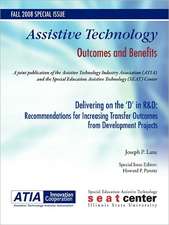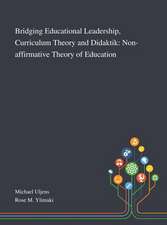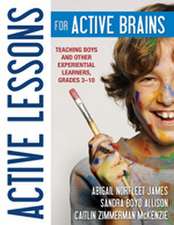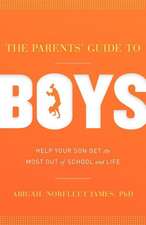Teaching the Male Brain: How Boys Think, Feel, and Learn in School
Editat de Abigail Norfleet Jamesen Limba Engleză Paperback – 29 apr 2015
- Classic, time-tested research combined with cutting-edge findings that the author has applied with success in her own classroom
- A qualitative and quantitative research base
- Useful examples, case studies, and dilemmas that teachers of boys may experience
- Numerous differentiation strategies for the heterogeneous classroom
- Trouble-shooting sections
- Strategies that have been tested, refined, and used successfully in the classroom
Preț: 333.43 lei
Nou
Puncte Express: 500
Preț estimativ în valută:
63.80€ • 66.62$ • 52.68£
63.80€ • 66.62$ • 52.68£
Carte tipărită la comandă
Livrare economică 15-29 aprilie
Preluare comenzi: 021 569.72.76
Specificații
ISBN-13: 9781483371405
ISBN-10: 1483371409
Pagini: 352
Ilustrații: illustrations
Dimensiuni: 178 x 254 x 27 mm
Greutate: 0.7 kg
Ediția:Second Edition
Editura: SAGE Publications
Colecția Corwin
Locul publicării:Thousand Oaks, United States
ISBN-10: 1483371409
Pagini: 352
Ilustrații: illustrations
Dimensiuni: 178 x 254 x 27 mm
Greutate: 0.7 kg
Ediția:Second Edition
Editura: SAGE Publications
Colecția Corwin
Locul publicării:Thousand Oaks, United States
Recenzii
“This book can be described as the definitive A-Z of teaching boys. Everything, from what makes boys tick to helping them fulfill their potential, is covered in this book. There is a good blend between cognitive theories and psychology, and I found it difficult to put the book down because it answers so many of the questions raised, on a daily basis, in boys’ schools by staff and parents. It was refreshing to finally find a book that not only explains the uniqueness of boys but provides the solutions that helps them succeed academically. The book clarifies in readable and understandable language many intuitive feelings that teachers have when teaching boys. Every teacher in a boys’ school, or a co-ed school for that matter, should have a copy because it is so refreshing to find a book that focuses on the importance of skills in teaching. It is a remarkable and delightful book which, having been crafted from the writer’s own experience, makes it hugely relevant.”
“Dr. James states that 'It is important to approach teaching from a gendered perspective, as not all students learn the same way and teaching them as if they did will not change that fact.' This is the perspective we ask our teachers to take at Allen Middle School in Greensboro, NC. We have several blended classes consisting of heterogeneous, all girls and all boys. Dr. James helped our teachers realize the uniqueness of each student. The strategies and concepts she shared during staff development helped us launch blended classes to best meet the needs of our students. Her book is a practical tool for the classroom teacher. It provides teachers with a plethora of practical, promising practices to motivate and encourage students to perform at or above their potentiality level.”
“Teaching the Male Brain, Second Edition by Dr. Abigail James is a holistic tool for educators, parents, and/or individuals committed to effectively understand, teach, support, and guide the development of young men in their care. Dr. James provides a clear lens into the intricate details of the thoughts and actions of the boys in our lives.”
“Dr. James states that 'It is important to approach teaching from a gendered perspective, as not all students learn the same way and teaching them as if they did will not change that fact.' This is the perspective we ask our teachers to take at Allen Middle School in Greensboro, NC. We have several blended classes consisting of heterogeneous, all girls and all boys. Dr. James helped our teachers realize the uniqueness of each student. The strategies and concepts she shared during staff development helped us launch blended classes to best meet the needs of our students. Her book is a practical tool for the classroom teacher. It provides teachers with a plethora of practical, promising practices to motivate and encourage students to perform at or above their potentiality level.”
“Teaching the Male Brain, Second Edition by Dr. Abigail James is a holistic tool for educators, parents, and/or individuals committed to effectively understand, teach, support, and guide the development of young men in their care. Dr. James provides a clear lens into the intricate details of the thoughts and actions of the boys in our lives.”
Cuprins
Foreword - Bradley Adams
Acknowledgments
About the Author
Introduction
Substantiating Research
How the Book Is Structured
Learning Objectives
Part I. Sex and Gender Differences in the Classroom
Chapter 1. Brain Basics
Are Brains Gendered?
Anatomy of the Brain
Sex Differences in Brain Function
Cognitive Skills
Chapter 2. Sensory Differences
Vision
Hearing
Touch
Learning Modalities
Sensory Differences and Learning
Chapter 3. Physical Differences
Activity Levels
Gross Motor Development Versus Fine Motor Development
Targeting
Handedness and Dexterity
Growth Patterns
Physical Differences and Learning
Chapter 4. Cognitive Differences
Verbal and Language Skills
Practice the Skills Necessary for the SAT, ACT, NAEP, and Other Standardized Tests
Spatial Abilities
Learning Modalities
Strategy Development
Cognitive Differences and Learning
Part II. Societal and Biological Influences
Chapter 5. ADHD and Learning Disabilities
Attention—ADHD
Medication
The “At Risk” Student
Sleep
Attentional and Learning Problems
Chapter 6. Social and Emotional Differences
The Brain and Emotions
Emotional Vocabulary
Aggression and Bullying
Competition and Cooperation
Puberty
Alcohol and Drugs
Social Influence on School
School and Masculinity
Learning Applications
Emotions and Learning
Chapter 7. Students With Other Risks
Teachers
Culture
Adults
Boys in Foster Care
Boys With Cultural, Linguistic, or Socioeconomic Differences and School
Part III. Strategies and Resources for Teaching the Male Brain
Chapter 8. Classroom Management Strategies
Home Influence
Discipline
Self-Control
Technology
Classroom Management and Learning
Chapter 9. Content-Specific Suggestions
English/Language Arts
Mathematics
History/Social Studies
Science
Foreign Languages
Fine Arts, Music, and Drama
Computer Skills
Individual Disciplines and Learning
Chapter 10. Gendered Education: Teaching Boys and Girls Together
Boys and Girls as Learners
Sex and Gender Differences in the Classroom
Gendered Education and Learning
Chapter 11. Effective Teaching
Differentiated Instruction
Multiple Intelligences
Learning Modalities
Unit Design
Empowering Boys as Learners
Test-Taking Strategies
Final Words
Chapter 12. Resources and Other Helps
Books of Interest
Rubrics
Learning Style Assessments
Resources
Books for Boys Ages 6–9
Books for Boys Ages 9–13
Books for Boys Ages 13–18
Graphic Novels
References
Index
Acknowledgments
About the Author
Introduction
Substantiating Research
How the Book Is Structured
Learning Objectives
Part I. Sex and Gender Differences in the Classroom
Chapter 1. Brain Basics
Are Brains Gendered?
Anatomy of the Brain
Sex Differences in Brain Function
Cognitive Skills
Chapter 2. Sensory Differences
Vision
Hearing
Touch
Learning Modalities
Sensory Differences and Learning
Chapter 3. Physical Differences
Activity Levels
Gross Motor Development Versus Fine Motor Development
Targeting
Handedness and Dexterity
Growth Patterns
Physical Differences and Learning
Chapter 4. Cognitive Differences
Verbal and Language Skills
Practice the Skills Necessary for the SAT, ACT, NAEP, and Other Standardized Tests
Spatial Abilities
Learning Modalities
Strategy Development
Cognitive Differences and Learning
Part II. Societal and Biological Influences
Chapter 5. ADHD and Learning Disabilities
Attention—ADHD
Medication
The “At Risk” Student
Sleep
Attentional and Learning Problems
Chapter 6. Social and Emotional Differences
The Brain and Emotions
Emotional Vocabulary
Aggression and Bullying
Competition and Cooperation
Puberty
Alcohol and Drugs
Social Influence on School
School and Masculinity
Learning Applications
Emotions and Learning
Chapter 7. Students With Other Risks
Teachers
Culture
Adults
Boys in Foster Care
Boys With Cultural, Linguistic, or Socioeconomic Differences and School
Part III. Strategies and Resources for Teaching the Male Brain
Chapter 8. Classroom Management Strategies
Home Influence
Discipline
Self-Control
Technology
Classroom Management and Learning
Chapter 9. Content-Specific Suggestions
English/Language Arts
Mathematics
History/Social Studies
Science
Foreign Languages
Fine Arts, Music, and Drama
Computer Skills
Individual Disciplines and Learning
Chapter 10. Gendered Education: Teaching Boys and Girls Together
Boys and Girls as Learners
Sex and Gender Differences in the Classroom
Gendered Education and Learning
Chapter 11. Effective Teaching
Differentiated Instruction
Multiple Intelligences
Learning Modalities
Unit Design
Empowering Boys as Learners
Test-Taking Strategies
Final Words
Chapter 12. Resources and Other Helps
Books of Interest
Rubrics
Learning Style Assessments
Resources
Books for Boys Ages 6–9
Books for Boys Ages 9–13
Books for Boys Ages 13–18
Graphic Novels
References
Index
Descriere
Showing the connection between neurobiology and learning from a gendered perspective, the author provides classic, time-tested research combined with cutting-edge findings applied successfully in her own classroom.














